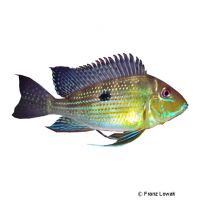Eartheater Cichlid (Geophagus argyrostictus)
| Eartheater Cichlid Geophagus argyrostictus | |
|---|---|
| Name | Eartheater Cichlid |
| Name Lat. | Geophagus argyrostictus |
| Family | Cichlids |
| Family lat. | Cichlidae |
| Order | Cichlids |
| Order lat. | Cichliformes |
| Origin | South America |
| Habitat | Stagnant water bodies |
| Diet | Omnivore |
| pH | 6.0-7.5 |
| Behavior | Peaceful |
| Keeping | Pair, group |
| Care Level | Difficult |
| Reproduction | Substrate spawner |
| Breeding | Moderately difficult |
| Life Span | 8-10 years |
| Protection | No |
| Metric Units | |
| Size | 16-18 cm |
| Temperature | 26-30 °C |
| Hardness | 2-10 °dH |
| Aquarium | 300 l |
| US Units | |
| Size | 6.3"-7" |
| Temperature | 79-86 °F |
| Hardness | 36-178 ppm |
| Aquarium | 80 gal |
Distribution and habitat
The tear-stripe terrestrial eaters are widespread in the upper and lower Rio Xingu basins. They prefer slow flowing or stagnant river sections, bays and lakeshore zones with sandy bottoms, roots and stones. Several different colored site variants are known.
Maintenance
The aquarium should be equipped with hiding places (crevices and caves) from stones and roots, as well as robust planting. A soft, deep substrate covered with some foliage (e.g. sea almond leaves) and slightly dim light (floating plants) is ideal
No ammonia, ammonium and nitrite should be detectable in the water, and the nitrate value should not exceed 100 mg/l. To ensure water quality and oxygen content, a filter and heater adapted to the size of the aquarium is required, as well as lighting for the species-appropriate day-night rhythm of the animals.
Diet
The food supply consists of live, frozen and dry food. For a balanced diet, feed once daily with a high-quality sinking dry food (granules, pellets, tablets) as well as tubifex, artemia, mysis, mosquito larvae or shrimp (live or frozen). In addition, they need regular vegetable food, such as blanched leafy and wild vegetables, algae leaves or dry food with vegetable ingredients (e.g. spirulina). It is recommended to feed small portions several times a day. Only feed as much as will be eaten within a few minutes. A regular and varied diet promotes health.
Behaviour and compatibility
They should be kept in pairs or better in a group of 5-8 animals. In too small groups the intra-species aggressiveness increases. They are only territorial during the spawning season. Keeping a group is only recommended in a larger and richly structured tank. They are compatible with other fish and can be socialized well with calmer, more warmth-demanding fish. Basically, only compatible fish species with similar demands on water quality and water temperature may be socialized.
Sex dimorphism
The slightly larger male usually has a longer extended dorsal and anal fin and a pointed genital papilla, which is round in the female. In juveniles it is difficult to determine the sex.
Reproduction and breeding
They are open breeders and practice brood care (parental family). The female usually spawns 200-250 eggs on a well-cleaned, smooth stone. After 3-4 days the fry hatch and are then housed by the parents in a bottom pit until they swim free after another 4-8 days. The fry are guarded by both parents for a few more days and are led to feeding areas in the aquarium before brood care ends.
Fry must be fed several times a day with special rearing food (Artemia nauplii). In community tanks breeding is hardly possible, because the fry are easy prey.
Important
They rummage through the substrate in search of food. According to this species-typical behavior, they are also called soil eaters. Plants are not eaten, but should be placed in pots and secured with stones against digging out.
The well-being of the fish should be checked regularly. Temperature should be checked daily, pH, hardness and nitrate levels should be checked at least every 14 days. Regular partial water changes are recommended, even if the contaminant level has not yet reached the upper limit. Sudden changes in water quality should be avoided. Newly introduced fish must be accustomed slowly to the water in the aquarium.
Further literature can be found in your pet store.
References
Text: petdata; Image: Franz Lowak
Source: BMELV (1998): Tierschutzgutachten - Haltung von Zierfischen (Süßwasser); BAENSCH & RIEHL (2004): Aquarien Atlas Bd. 4, Mergus Verlag; ENGELMANN (2005): Zootierhaltung - Tiere in menschlicher Obhut: Fische, Verlag Harri Deutsch
- Gemäß § 21 Abs. 5 Tierschutzgesetz idgF
